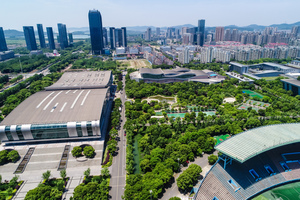Tips and Tricks to Find the Best Industrial Properties in the Philippines
Body
Finding the perfect industrial properties in the Philippines has grown more complicated as companies struggle with mounting operational expenses, tighter regulatory measures, and demands for flexible spaces that can handle fast expansion. With demand for logistics centers and manufacturing facilities soaring, companies tend to compromise on location, infrastructure, or scalability. In this competitive marketplace, selecting the appropriate industrial property is paramount to achieving long-term success and operating efficiency, thus making it vital for companies to put strategic priorities at the top of their mind when deciding on their next site.
Industrial Properties and Their Importance
What Are Industrial Properties?
Industrial properties are buildings utilized for manufacturing, warehousing, logistics, or distribution. These structures normally consist of warehouses, factories, cold storage warehouses, and industrial parks. In the Philippines, these properties are essential to fuel the nation's expanding supply chain, e-commerce, and export sectors. As demand increases, businesses and investors are looking more and more towards industrial real estate as a long-term asset that can drive productivity and operational efficiency—particularly in strategic areas surrounding Metro Manila, CALABARZON, and Central Luzon.
Industrial Properties for Business Growth
Industrial properties are beneficial to production, warehousing, and distribution businesses that need control over operations and economies of cost. Having your own space for logistics or manufacturing activities reduces interruption, saves you outsourcing expenses, and enables you to customize the area according to your workflow. With traffic congestion and infrastructure constraints a problem in the Philippines, gaining possession of an industrial lot located in an excellent area gives one a competitive advantage. This is particularly crucial for companies growing rapidly, entering new markets, or streamlining their supply chains.
Key Factors to Consider
Location and Accessibility
Access to ports, highways, airports, and labor pools will either make or break an industrial enterprise. Situations near the North Luzon Expressway (NLEX), South Luzon Expressway (SLEX), or key seaports will facilitate quicker movement of materials and lower transportation expenses. Opting for a locale with good road access assures your employees and vendors will be able to reach you unimpeded. Areas near Metro Manila tend to find the ideal mix of accessibility and cost.
Infrastructure and Utilities
A building’s ability to support 24/7 operations depends on reliable access to power, water, telecommunications, and waste management infrastructure. For industries that rely on heavy equipment or refrigeration, consistent electricity and high-capacity utilities are essential. Many industrial parks offer pre-installed utility lines and backup power, helping reduce setup time and initial expenses. Ensure the building allows for utility expansion or future upgrades to avoid costly adjustments down the line.
Zoning and Compliance with Local Regulations
Zoning regulations define the type of business activity permitted on a property. In the Philippines, local government units (LGUs) manage zoning, and non-compliance can lead to fines or even closure. Always confirm the classification of the property—industrial, commercial, or agricultural—before signing any contracts. Environmental compliance should also be verified, especially for manufacturing operations. Consulting with zoning experts can streamline approvals and reduce legal risks.
How to Evaluate the Best Industrial Properties
Assessing the Property's Size and Layout
A building that's too small limits future expansion, while one that's excessively large can result in avoidable costs. Consider the layout—does it support smooth production flow or optimal racking for storage? Can it accommodate trucks for easy loading and unloading? Column-free interiors and high ceilings typically offer better flexibility. For manufacturing operations, evaluate the floor load capacity, ventilation, and adaptability of the floor plan. The goal: find a space that fits your current needs while allowing room for future growth.
Infrastructure and Facility Management
Look beyond basic amenities. Does the property have security systems, drainage, road networks, and disaster-preparedness plans? Properly managed industrial properties offer better safety, faster troubleshooting, and less downtime. Facilities that handle maintenance, landscaping, and repairs in-house can ease your operations. In the Philippines, where typhoons and flooding are common, well-drained land and modern structural planning can prevent costly damages and delays.
Evaluating Long-Term Costs and ROI
Industrial properties require significant capital—but they can yield high returns when selected wisely. Consider the total cost of ownership: taxes, maintenance, renovation, and logistics. Some areas may have tax incentives or economic zone benefits that reduce costs. Assess the property’s appreciation potential, especially if it’s near upcoming infrastructure projects or growth corridors. Whether leasing or buying, focus on long-term ROI, not just the purchase price. A well-placed industrial site can become a key business asset.
Leveraging Expert Advice in Industrial Property Selection
Why Partner with Real Estate Experts?
Navigating the industrial property market requires more than a Google search. Experts can identify hidden opportunities, negotiate better lease or purchase terms, and flag red flags during due diligence. Their market knowledge helps ensure you’re paying a fair price while staying compliant with local laws. Professionals also assist in site inspection, documentation, and zoning checks—saving you time and costly mistakes. For first-time buyers or expanding firms, this guidance is essential.
The Role of Industrial Property Developers
Developers don’t just build—they create ecosystems designed for industrial use. These master-planned developments often include built-in infrastructure, security, waste systems, and access to utilities. Developers also have partnerships with logistics providers, government agencies, and utility firms, which can speed up your setup. Choosing a property within a professionally developed park reduces risk and supports seamless operations, especially for manufacturers or exporters needing reliable support systems.
Sustainable Practices for Your Industrial Property Investment
Incorporating Green Technologies
Green buildings aren’t just trendy—they cut costs and future-proof your investment. Solar panels, LED lighting, rainwater catchment systems, and energy-efficient HVAC setups help lower utility bills and reduce your carbon footprint. In the Philippines, where electricity prices are among the highest in Asia, these features can save businesses millions in the long run. Government incentives for eco-friendly upgrades also boost your ROI and environmental compliance.
Future Trends in Industrial Property Development
Look beyond the basic amenities. Are there security systems, proper drainage, road access, and disaster preparedness measures in place? Well-managed industrial buildings offer better safety, faster troubleshooting, and less downtime. Facilities that include maintenance, landscaping, and repair services can streamline your operations. In the Philippines, where typhoons and flooding are common, well-drained land and modern structural design can help prevent costly damage and project delays.
Key Takeaway
Industrial properties in the Philippines offer businesses a strategic way to scale operations without sacrificing efficiency or cost control. From location access to built-in infrastructure and sustainability features, these spaces support faster operations, flexible layouts, and long-term savings. They solve key industry challenges like rising logistics costs, zoning restrictions, and lack of infrastructure—all while providing room to grow. Investing in the right industrial site isn’t just smart—it’s a forward-thinking move that positions your business for resilience, growth, and adaptability in a competitive market. Now’s the time to act and secure that operational edge.









Comments